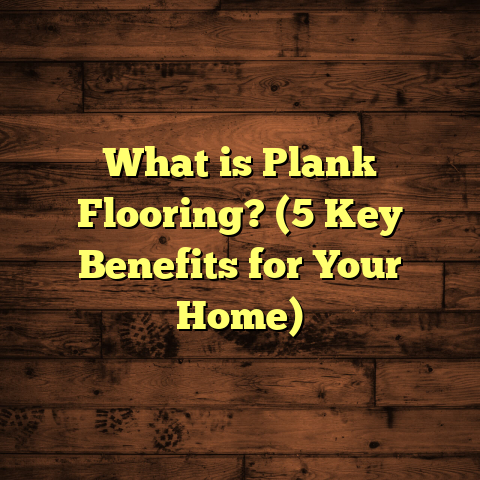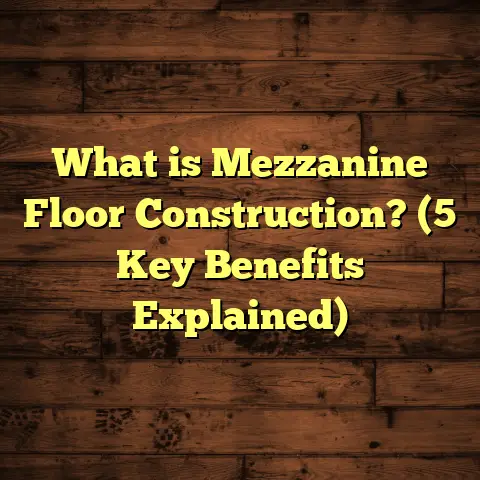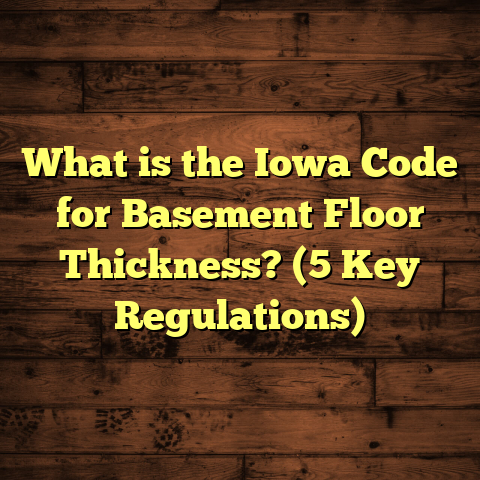What is Rolled Kitchen Flooring Called? (5 Essential Types Revealed)
I still remember the first time I helped a client pick out rolled kitchen flooring for their home. It was a cozy little kitchen in a neighborhood I knew well. The homeowners were excited but also a bit overwhelmed by all the flooring options out there. They wanted something durable, easy to clean, and budget-friendly — but also something that would add a bit of character to their space. We ended up choosing a vinyl sheet floor, and the whole process sparked my interest in rolled kitchen flooring options. Since then, I’ve installed many types of rolled flooring in kitchens across different homes and commercial spaces, and I’d love to share what I’ve learned along the way.
What Is Rolled Kitchen Flooring?
Rolled kitchen flooring is exactly what it sounds like: flooring material that comes in large, continuous sheets or rolls instead of individual tiles, planks, or blocks. These sheets are flexible and can be rolled up for transportation and storage, making them easier to handle than rigid flooring materials.
Rolled flooring is laid down by unrolling it across the kitchen floor and adhering it to the subfloor using glue or other fastening methods. Because it’s a single sheet (or a few large sheets), it creates a mostly seamless surface without grout lines or gaps. This feature makes rolled flooring especially popular in kitchens, where spills and crumbs call for easy cleaning and moisture resistance.
Most rolled flooring materials come in widths ranging from 6 feet (around 1.8 meters) to 12 feet (3.6 meters), sometimes even wider. Lengths vary but typically range from 12 feet up to 100 feet or more, so you can cover large floor areas with minimal seams.
Thickness varies by material but usually falls between 1mm and 6mm (about 0.04 to 0.24 inches). Thicker floors tend to be more comfortable and durable but cost more upfront.
Why Do People Choose Rolled Flooring for Kitchens?
From my experience, there are several reasons why rolled flooring is a go-to choice for kitchen floors:
- Seamless Surface: No grout lines mean fewer places for dirt and moisture to hide.
- Ease of Cleaning: Smooth sheets wipe down quickly — perfect for busy kitchens.
- Durability: Many rolled flooring types offer good resistance against stains, spills, and wear.
- Cost Efficiency: Rolled materials often cost less per square foot than hardwood or tile.
- Comfort: Some rolled floors provide cushioning underfoot, reducing fatigue during cooking.
- Speed of Installation: Large sheets cover a lot of area quickly, reducing labor time.
When I first started installing rolled floors, I was amazed at how efficiently they could transform a kitchen space.
Cost and Lifespan Overview
In terms of pricing, rolled kitchen flooring can range widely depending on the material:
| Flooring Type | Typical Cost Per Sq Ft (Installed) | Expected Lifespan |
|---|---|---|
| Vinyl Sheet | $2 – $5 | 10 – 20 years |
| Linoleum | $3 – $7 | 15 – 25 years |
| Rubber | $5 – $12 | 20+ years |
| Cork | $4 – $8 | 15 – 20 years |
| Marmoleum (Linoleum Composite) | $4 – $9 | 20+ years |
These ranges include both materials and professional installation costs. Installation time typically takes 1-3 days for an average kitchen (150-250 sq ft), depending on how much prep work the subfloor needs.
The Five Essential Types of Rolled Kitchen Flooring
Let me take you through each major type of rolled kitchen flooring I’ve installed or worked with extensively. I’ll share details about their features, pros and cons, costs, installation tips, and even some personal stories from my projects.
1. Vinyl Sheet Flooring
Vinyl sheet flooring is by far the most popular rolled option I deal with. It’s made from synthetic polyvinyl chloride (PVC) and comes in a huge variety of colors, patterns, and textures — including options that mimic natural materials like wood, stone, and ceramic tiles.
Features & Benefits
- Waterproof and highly resistant to stains.
- Available in thicknesses ranging from about 2mm to 3mm.
- Can have textured surfaces for slip resistance.
- Soft underfoot compared to tile or hardwood.
- Easy cleaning with just a mop or cloth.
Installation Insights
Installing vinyl sheets requires a clean, smooth subfloor — usually plywood or concrete. I always recommend checking for any imperfections because bumps can telegraph through thin vinyl sheets after installation.
The installation process involves rolling out the sheet carefully, trimming edges to fit around cabinets and walls, then applying a special adhesive underneath. The seams are sometimes heat-welded or glued tightly to ensure water doesn’t seep through.
For example, when I installed vinyl sheet flooring in my aunt’s kitchen (about 180 sq ft), the whole job took two days. We used a commercial-grade vinyl with a textured stone pattern that looked fantastic but was easy to maintain. The entire project cost roughly $900 including material ($3 per sq ft) and labor.
Cost Details
Prices for vinyl sheet flooring vary widely:
- Budget options start as low as $1.50 per sq ft (materials only).
- Mid-range commercial-grade sheets run $2.50 to $4 per sq ft.
- Luxury vinyl sheets with embossed textures and realistic designs cost $4 to $6 per sq ft.
Installation labor typically adds $1.50 to $3 per sq ft depending on complexity.
Personal Anecdote
One vinyl sheet project sticks out in my memory — a young couple with two active toddlers wanted durable floors that could handle spills, toys dropping, and heavy foot traffic. We went with a bright patterned vinyl sheet that hid dirt well. Two years later, they reported zero damage and said cleaning was a breeze — just soap and water!
2. Linoleum Flooring
Linoleum is another popular rolled kitchen floor option but it’s less known compared to vinyl. It’s made from natural materials like linseed oil, wood flour, cork dust, and pine resin. Because of its organic composition, it’s considered eco-friendly.
Features & Benefits
- Naturally anti-bacterial and anti-static.
- More rigid than vinyl but still flexible enough for rolled sheets.
- Thickness usually ranges from 2.5mm up to 4mm.
- Requires sealing after installation to protect against moisture.
- Can last up to 25 years with proper maintenance.
Installation Tips
Linoleum needs a smooth, level subfloor like vinyl. However, because it’s less flexible, careful handling during installation is crucial to avoid cracking or creasing.
Sealing is essential — I use water-based sealants that allow linoleum to breathe while protecting it from water damage. After sealing, I recommend routine resealing every 5 years or so for kitchens that see heavy use.
Costs Breakdown
Linoleum is generally pricier than vinyl due to its natural materials:
- Material costs range from $3 to $7 per sq ft.
- Installation adds approximately $2 to $3 per sq ft because of sealing steps.
For instance, I installed linoleum flooring in a client’s vintage kitchen remodel last year — about 220 sq ft total cost was near $1200 including sealing.
Case Study
A family renovating an old farmhouse wanted environmentally friendly materials with a natural look. Linoleum fit perfectly with their rustic theme while providing durability against kitchen messes. They’ve been happy with their floor for over three years now without any major issues.
3. Rubber Flooring Rolls
Rubber rolls are less common for residential kitchens but great for people who prioritize comfort and safety. Rubber floors offer excellent cushioning which reduces fatigue if you cook for hours on end.
Features & Benefits
- Anti-slip surface reduces accidents.
- Thickness varies from about 3mm up to over 6mm.
- Naturally resistant to water and stains.
- Durable enough for high-traffic areas.
- Noise-dampening properties.
Installation Details
Rubber rolls require special adhesives and careful subfloor prep because they’re heavier than vinyl or linoleum sheets.
I usually recommend professional installation because rubber can be tricky to cut precisely around tight corners or cabinetry.
Pricing Information
Rubber flooring costs more than vinyl or linoleum:
- Materials range from $4 to $10 per sq ft.
- Labor is higher due to specialized adhesives — around $3-$5 per sq ft.
One commercial kitchen client chose rubber rolls for their prep station floors where employees stand all day; they reported less foot pain and fewer slips after installation.
4. Cork Flooring Rolls
Cork is an interesting rolled flooring choice that combines softness with natural appeal. It comes from the bark of cork oak trees and offers warmth underfoot along with sound absorption qualities.
Features & Benefits
- Thickness generally between 4mm and 6mm.
- Naturally antimicrobial.
- Soft yet resilient surface.
- Moisture resistant but not fully waterproof — needs sealing.
- Eco-friendly renewable resource.
Installation Notes
Cork rolls need smooth subfloors too and must be sealed immediately after installation to protect against kitchen spills.
I once installed cork roll flooring in a beachside home where the owners loved barefoot comfort combined with a sustainable product. The cork’s subtle grain patterns added character without overwhelming the space visually.
Cost Range
Cork roll flooring is moderately priced:
- Materials cost about $3.50-$6 per sq ft.
- Installation usually adds another $2-$3 per sq ft due to sealing requirements.
5. Marmoleum (Sheet Linoleum Composite)
Marmoleum is a brand name for linoleum composite sheets that have gained popularity due to their durability and low environmental impact. They come in wide rolls with vibrant color options and patterns.
Features & Benefits
- Thickness around 2mm to 3mm.
- Low VOC emissions make it great for indoor air quality.
- Easy-to-clean surface.
- Long lifespan (20+ years).
- Available in modular sheets for easy pattern design.
Installation Tips
Marmoleum requires similar preparation as linoleum — smooth subfloors and sealing after installation are key steps.
I used Marmoleum in a school cafeteria renovation where hygiene standards were strict; its antimicrobial properties were highly valued by the facility managers.
Pricing Details
Marmoleum costs range:
- Materials between $4-$9 per sq ft depending on design.
- Installation costs about $2-$3 per sq ft with sealing included.
My Process for Estimating Costs Using FloorTally
Estimating precise costs has always been one of the trickiest parts of my job as a flooring contractor. Early on, I’d spend hours measuring rooms manually, calculating waste factors, then calling suppliers for quotes on materials and labor rates.
That changed when I started using FloorTally — an online tool that streamlines all those steps into one interface. Here’s how it helps me every time:
- Accurate Measurements: I enter room dimensions including length, width, any cutouts or alcoves.
- Material Selection: I pick from a wide range of materials like vinyl sheet or cork rolls.
- Waste Factor Calculation: The tool automatically adds appropriate percentages (usually between 5%–10%) for waste due to cuts or mistakes.
- Local Cost Inputs: FloorTally lets me input local labor rates based on my area which can vary widely.
- Instant Total Cost Estimates: I get immediate totals including materials + labor + waste calculations so I can provide clients accurate budgets fast.
For example: When estimating costs on a typical 200 sq ft kitchen using mid-grade vinyl sheet flooring with a 7% waste factor in my city (where labor is about $2 per sq ft), FloorTally generated an estimate of around $1200 total—saving me hours compared to traditional methods.
This tool has become indispensable for both small DIY projects and larger contractor bids alike.
What Should You Consider Before Choosing Rolled Kitchen Flooring?
If you’re thinking about rolled flooring for your kitchen, keep these points in mind:
Traffic & Durability Needs
Is your kitchen high traffic? Vinyl and rubber tend to hold up better under heavy use than cork or linoleum unless properly maintained.
Comfort Level Underfoot
If you spend long hours cooking or baking, softer options like cork or rubber can reduce fatigue better than harder materials like Marmoleum or linoleum.
Moisture Resistance
Kitchens are prone to spills so waterproof materials like vinyl sheet are safest choices unless you’re willing to seal regularly (linoleum/cork).
Budget Constraints
Vinyl usually offers the best price-to-performance ratio but if sustainability matters more you might lean toward linoleum or cork despite higher upfront costs.
Maintenance Requirements
Consider how much effort you want to spend maintaining your floor over time — some types need resealing every few years while others require almost none beyond regular cleaning.
Real Stories From My Projects With Rolled Kitchen Flooring
I’ve shared some examples above but here are a few more quick stories from projects where rolled kitchen floors really made an impact:
- A young couple remodeling their first home chose an affordable vinyl sheet floor with wood-look grains at about $2/sq ft installed; they loved how warm it made their kitchen feel without sacrificing durability.
- An elderly client wanted cork rolls installed because they found hardwood floors too hard on their knees; after sealing properly the floor stayed stain-free for over five years despite daily cooking activity.
- A busy family with pets picked rubber roll flooring for their open-concept kitchen/dining area as it was slip-resistant even when wet; even after three years the floor looked almost new thanks to its resilience.
How Long Does Rolled Kitchen Flooring Last?
Lifespan depends heavily on material choice:
| Material | Expected Lifespan (Years) | Factors Affecting Longevity |
|---|---|---|
| Vinyl Sheet | 10 – 20 | Quality of vinyl; proper installation |
| Linoleum | 15 – 25 | Regular sealing; avoiding standing water |
| Rubber | 20+ | Maintenance; heavy traffic levels |
| Cork | 15 – 20 | Sealing frequency; moisture exposure |
| Marmoleum | 20+ | Cleaning regimen; sealing |
Proper care is essential regardless of material — wiping spills quickly and avoiding harsh chemicals helps extend life significantly.
Wrapping Up My Thoughts on Rolled Kitchen Flooring
Rolled kitchen flooring offers incredible variety—from highly affordable vinyl sheets to eco-friendly linoleum or cork options—allowing homeowners to pick floors that match both their style and practical needs. The seamless look combined with ease of maintenance makes these materials especially suited for kitchens where cleanliness matters most.
If you’re planning a renovation or new build and want something quick to install yet durable enough to withstand daily wear-and-tear, consider one of these five essential rolled floor types:
- Vinyl Sheet Flooring
- Linoleum Flooring
- Rubber Flooring Rolls
- Cork Flooring Rolls
- Marmoleum (Sheet Linoleum Composite)
Measure carefully including waste factors (~5–10%), use tools like FloorTally to estimate costs accurately based on your local rates, then choose the best match considering comfort, budget, moisture exposure, and maintenance preferences.
I hope my experiences help guide you toward the perfect rolled kitchen floor for your home! If you want help figuring out what’s best based on your specific space or budget, just ask — I’m always happy to share tips from my years working hands-on with these materials!





